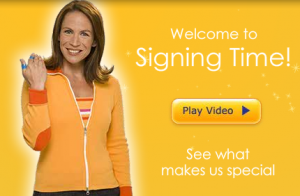 Last week, Sasha, now all of 15.5 months old, did something new: She signed. Now, she’d signed before—an occasional grasping hand for milk, fluttering both hands for “all done”—but this time she paired the sign, touching the tips of her fingers together on each hand, with a spoken word: “More.” And she did it again and again. It was pretty cool, much cooler, somehow, than her first actual spoken word, which was something like “Bye-bye.”
Last week, Sasha, now all of 15.5 months old, did something new: She signed. Now, she’d signed before—an occasional grasping hand for milk, fluttering both hands for “all done”—but this time she paired the sign, touching the tips of her fingers together on each hand, with a spoken word: “More.” And she did it again and again. It was pretty cool, much cooler, somehow, than her first actual spoken word, which was something like “Bye-bye.”
First off, this is, finally, indisputable proof that TV Is Good. Because about nine months ago, Sasha started watching the DVD of Baby Signing Time, a musical lesson in the basics of American Sign Language. It’s an entertaining 25 minutes, and she’s always gazed at it in rapt attention. Now, it seems to have taught her something (besides how to pick up the remote control, point it at the TV and say, “Baby!”).
But what’s really neat is that “more” isn’t just a word. Unlike, say, dog or milk, it’s an abstract concept, evidence that her mind is working on a human level. And it’s not her only spoken concept. She now regularly says “Bao-bao,” Mandarin for “Pick me up.” Yes, she can also say various nouns (among them the Chinese words for dog and milk), but that’s less impressive than her figuring out that if she’s finished chomping one grape, there exist somewhere “more” grapes. Her other abstract word is “Okay,” which signals assent and acceptance, concepts I’m still having trouble with. Soon, I imagine, Sasha will be counting. And then it’ll be time for a post-doc.
This whole process fascinates me because I’m almost always trying to improve my own language skills. I speak French, Italian, Spanish, Mandarin and Vietnamese, most of them extremely badly, though well enough to order a meal and direct a taxi. And I often have to pick up bits of new languages on the fly—in a week, for example, I’m going to have to stumble through German, Slovak, and Hungarian. There are phrase books to study, sure, but studying takes time, which I never have. If only I could pick up language the way Sasha does.
There is, of course, Rosetta Stone, the language-learning software that is big business nowadays. (It’s “used and trusted” by the State Department and the U.S. Army, they say.) Supposedly, the Rosetta Stone method involves learning a language the way a child would. Explains a video on Rosetta’s Website:
As a child, you learned language intuitively by experiencing the world around you. You saw something—let’s say a ball. Your parents told you that it’s a red ball. You repeated the words. Maybe they asked you to catch it, or throw it back to them. Without realizing it, you learned the object’s name, how to describe it, and what the actions are called.
This pitch sounds great, but after observing Sasha (who I have to take as an example of a normal child) I’m not so sure that’s how it works. I mean, surely she’s seen some kind of cause and effect related to the word “more,” but it’s absent all of those other associated nouns. She’s not saying “more grapes” or “more Baby Signing Time.” Just “more”—a concept divorced from its objects. It’s all very mysterious and fascinating to me, and I wish I could find a way to activate that process in my own brain.
Maybe reading this will help.

Agreed. When my son signed “more” a little less than a year ago, it was the most impressive thing I had seen him do to date. Mainly because, at the time, we were in the supermarket and two very attractive 20-somethings were fawning over him and paying him their undivided attention.
When they left, he had a perturbed look on his face. Then he turned to me and made the sign for more.
@Daddy Files – That’s simply magnificent!
@Matt – Baby sign is awesome and the feeling you get as a parent when you see your child sign back is incredible. Good for Sasha! Now, just teach her how to give the finger so when you get snarky looks at the pub, she can respond appropriately.
Babbel.com (http://www.babbel.com) is another language software that uses this idea of learning “intuitively” like a child to teach foreign languages — it involves images and a lot, lot of repetition!
The thing about language-learning software is that most users end up stalled at a certain point. They are doing well with the program but when it comes to actually speaking with native speakers of the language, they fall short. The reason why is that fluency (or even communicative competence) is fostered by interaction and engagement with others. The social aspect of language is so important; otherwise how are you actually producing meaning with your words? These software programs cannot replicate natural interactions which your children have with you and others as they learn their first language(s) and it’s the same for adult learners who are planning to travel. When you want to get your point across to an Austrian but you don’t know the exact words to use, has the computer program really prepared you for ways to work around that discrepancy?
You might find this blog entry on the subject interesting: http://www.wal.org/wordpress/index.php/2009/05/11/second-language-learning-and-software/
Pingback: A Week on the Wagon | DADWAGON
Pingback: A Spoon Is a Spoon Is a Spoon: How Babies Think | DADWAGON